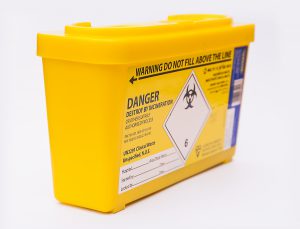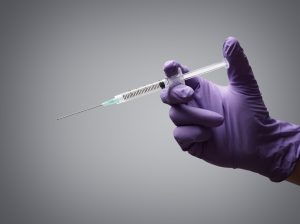If you generate any amount of medical waste, you are responsible for the proper disposal of it. Anything that has been contaminated with hazardous medical waste or other potentially infectious materials (OPIMs) must be sealed in the proper medical waste disposal containers and packaged before it is tossed to protect employees and the environment.
Laws have been established by the Department of Transportation (DOT) and the Occupational Safety and Health Administration (OSHA) that require certain storage and disposal techniques and specific containers for potentially harmful wastes. Knowing how to legally and safely store and dispose of your medical waste can be confusing. Using a professional service provider can make it a lot easier. This article will help get you on the right path as far as how to contain your medical waste while it’s in your possession, and how to package it for disposal.
How to Properly Store Medical Waste
You should not mix medical waste with normal trash. Therefore, organizations that produce medical waste should have secure bins or containers with clear labels where employees can place medical waste.
 Follow these guidelines to ensure you don’t mix your medical waste in with regular waste:
Follow these guidelines to ensure you don’t mix your medical waste in with regular waste:
- Keep sharps waste separated from regulated and common medical waste
- Make sure your receptacles are clearly and accurately labeled so employees know where to put specific waste types
- Keep the trash containers in a secure location where no one will accidentally become contaminated
- Keep cleaning/disinfecting equipment nearby so you can keep that area completely clean
- If anything mingles with your medical waste, treat it as medical waste too
Once the waste bins are full and you’re ready to throw them out, there are rules governing containment for transport and disposal. The Department of Transportation (DOT) has laws that apply nationally, but many medical waste disposal laws are enforced at the state level, so always be sure to check in with local policies before you act.
Proper Medical Waste Disposal Containers and Packaging
The DOT has strict laws concerning the containers that store medical waste during transport for disposal. Always make sure you label the contents of the containers. For instance, if it is biohazardous waste, mark the container with the biohazard symbol. Depending on how much waste you have to dispose of, the way you contain your medical waste differs.
Non-bulk Packaging
If you have a small amount or one type of regulated medical waste, you can follow the DOT guidelines for non-bulk packaging. Under these rules, you should place solid-regulated medical waste in red liner bags as long as they are closable and leak-proof. Liquids and sharps should be placed in thick liner bags and then placed inside rigid, puncture-resistant, and leak-resistant DOT-approved containers.
Bulk Packaging
Bulk packaging refers to large packages containing distinct, smaller packages of medical waste. The large packaging itself must be puncture-resistant and made of either metal or non-porous, rigid plastic, and be constructed, tested, and marked by United Nations packaging requirements.
If the large packaging contains any liquid waste, it must have enough absorbent materials to soak up all liquid present as a backup measure. If you use the large packaging method of disposal, the requirements for inner packing are as follows:
Solid Medical Waste
A plastic film bag (a red bag) is sufficient as the inner packaging for solid medical waste. It can hold liquid waste as long as there are also sufficient absorbent materials contained within the bag. The bag must be marked and certified as tear-resistant at up to 480 grams of pressure. Additionally, you must seal it properly (must be able to invert it for five minutes without leaking). They cannot weigh more than 22 lbs.
Liquid Medical Waste
The inner packaging for liquid waste must be rigid packaging conforming to UN standards that is puncture-resistant and leakproof. Inner packages containing liquid cannot weigh more than five pounds each.
 Sharps
Sharps
Sharps containers must be rigid, puncture-resistant, and completely sealable. These inner packages are reusable if they are approved and have marks for permanent reuse. Additionally, they’re disinfected between each use and have a capacity between two and forty gallons.
You can purchase medical waste disposal containers from medical supply companies, some pharmacies, and health care providers, or online. However, if you use a service provider, they will provide the proper containers for you, and dispose of everything correctly either through a mail-back system or by container pickup.
Services Designed with You in Mind
With mail-back services, your provider will send you everything you need. It includes an acceptable container for your waste, a shipping container, a prepaid shipping label, and instructions for the entire process. This type of service is great for smaller quantities of medical waste.
With container pickup services, your provider will give you a collection container to meet your capacity needs. Your service provider will stop by when it’s full to collect your medical waste and take care of the rest. If you regularly accumulate medical waste, this type of service is optimal.
When you use a service provider, you don’t need to worry about your containers at all. They take care of all the dirty work.
Medical Waste Pros Can Help You with Getting the Proper Medical Waste Disposal Containers
Medical Waste Pros understands the importance of the proper storage and disposal of medical waste. We have professionals who have been in the industry for years, are fully aware of all federal and state laws, and know medical waste disposal best practices by industry.
Call us today at (888) 755-6370 or fill out the form to receive free quotes on medical waste disposal services near you. We will make sure to dispose of your medical waste properly, so you can focus on what you do best.







